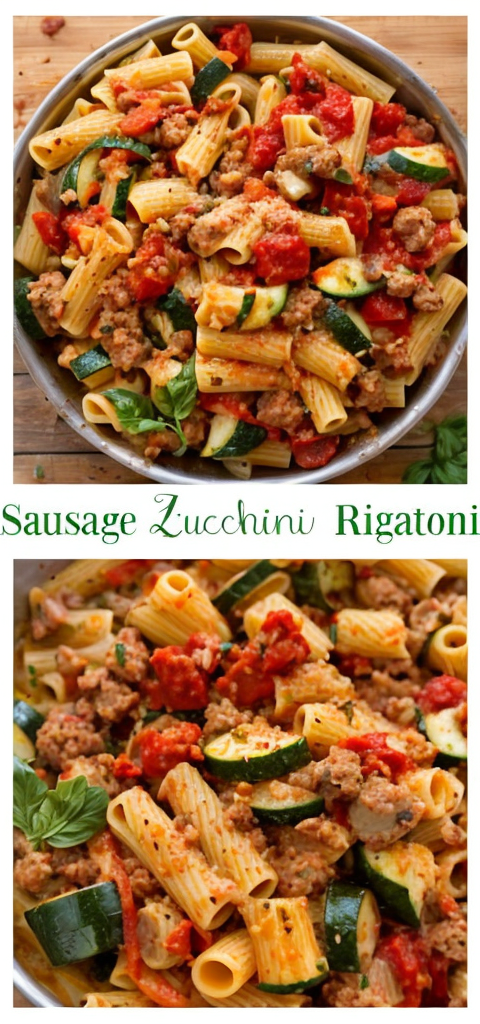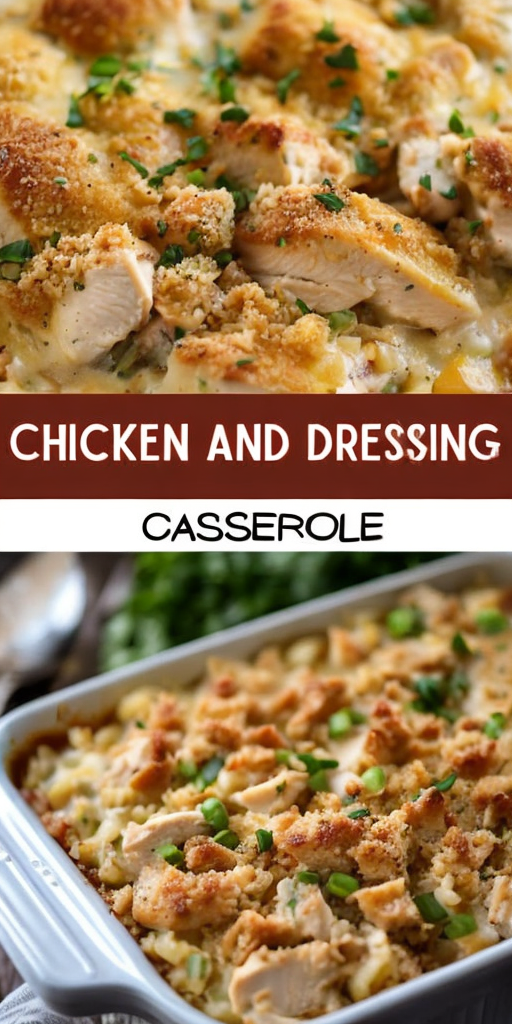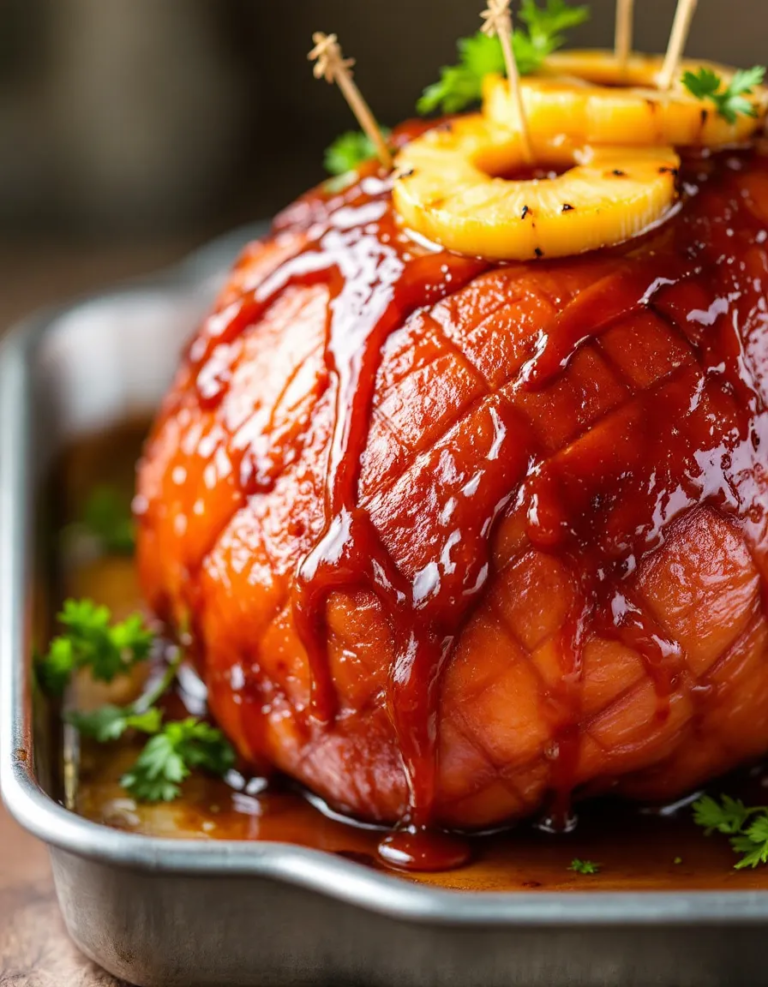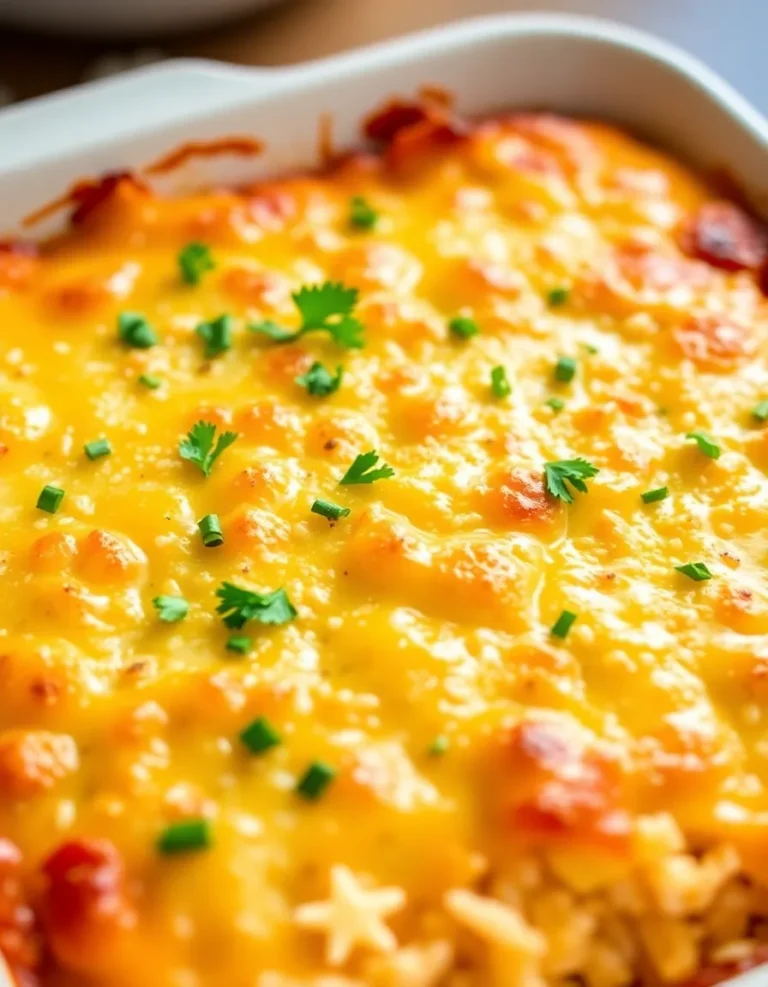Easy Rigatoni with Sausage & Zucchini (Ready in 30)
Easy Rigatoni with Sausage & Zucchini: A Quick Italian Delight
Escape the mundane weeknight meal routine with this Easy Rigatoni with Sausage & Zucchini dish. A delight for your taste buds, this Italian-inspired pasta recipe combines succulent sausage, fresh zucchini, and al dente rigatoni in a luscious, savory sauce. Bursting with flavor and ready in just 30 minutes, it’s a go-to for busy weeknights when time is of the essence but quality and taste are non-negotiable.
The combination of spicy sausage and tender zucchini makes this rigatoni dish a symphony of textures and flavors, satisfying even the most discerning of palates. The noodles soak up the garlic and tomato-infused sauce, while the zucchini adds a fresh contrast to the rich sausage. This quick and easy pasta recipe is bound to become a staple in your culinary repertoire.
Quick Recipe Highlights
- Flavor Profile: The savory sausage complements the lightness of zucchini with hints of garlic and herbs.
- Texture: Rigatoni holds up perfectly to the robust sauce, while the zucchini remains tender but crisp.
- Aroma: A hearty blend of garlic, sausage, and herbs creates an irresistible aroma that fills your kitchen.
- Visual Appeal: Vibrant green zucchini slices against the backdrop of rich red sauce and golden brown sausage offer a feast for the eyes.
- Skill Level Needed: Perfect for beginners and experienced cooks alike, this dish requires just basic cooking techniques.
- Special Equipment: A large pot for boiling and a skillet for sautéing are all you need.
Recipe Overview
- Difficulty Level: With minimal chopping and straightforward cooking steps, this recipe is rated easy.
- Category: This is a versatile main course perfect for lunch or dinner.
- Cuisine: The dish takes cues from traditional Italian pasta recipes, known for rich flavors and simple preparation.
- Cost: Economical, using easily accessible and affordable ingredients like sausage, zucchini, and pasta.
- Season: Best enjoyed all year round, but particularly cherished in summer when zucchini is freshest.
- Occasion: Suitable for casual family dinners, quick lunches, or an impromptu get-together.
Why You’ll Love This Recipe
The Easy Rigatoni with Sausage & Zucchini boasts an unbeatable combination of savory sausage and garden-fresh zucchini. The rigatoni pasta is the ideal carrier for the rich flavors, ensuring each bite is flavorful and fulfilling. The choice of using spicy sausage adds a heat element that is perfectly balanced by the mild sweetness of the zucchini. This contrasts beautifully against the chewy pasta, creating an enjoyable texture interplay.
Convenience plays a huge role in the appeal of this dish. It can be whipped up in 30 minutes, making it the ideal choice for weeknight dinners when you’re short on time but don’t want to compromise on deliciousness. With just a few basic cooking steps, it’s approachable for both novice cooks and seasoned chefs seeking a reliable, delicious meal.
In terms of nutrition, the inclusion of fresh zucchini brings vitamins and minerals to the table. Zucchini is low in calories and high in dietary fiber, aiding digestion and promoting a healthy gut. Sausage provides protein, while rigatoni adds the carbohydrates necessary for a balanced meal. The sauce, made with fresh or canned tomatoes, contributes lycopene, an antioxidant beneficial for heart health.
Socially, this recipe can be the centerpiece of a gathering or an intimate meal. It’s versatile enough to serve at various events, from a casual dinner party to a family-style meal. Pair it with a simple green salad and a glass of wine for a complete culinary experience that is as delightful to share as it is to savor individually.
The cost-effectiveness of this recipe is another plus. By using in-season vegetables and common pantry staples, you can serve up a restaurant-quality meal without the hefty price tag. With just a few ingredients, it’s accessible and budget-friendly, ensuring you can incorporate it into your meal rotation often.
Historical Background and Cultural Significance
The roots of Easy Rigatoni with Sausage & Zucchini lie in the Italian culinary tradition, where pasta dishes are a staple. Pasta, in various shapes and forms, has been a part of Italian cuisine for centuries, dating back to the days when Roman armies carried it as part of their rations. The use of sausage in Italian cooking can be traced to ancient times, with each region in Italy having a unique take on sausage flavors and ingredients.
Culturally, pasta dishes like rigatoni are synonymous with family gatherings in Italy, where recipes are handed down through generations. The importance of pasta in Italian culture is immense, often seen as a comfort food that brings families together. Rigatoni, with its tube-like shape, is ideal for capturing hearty sauces, making it a popular choice in many Italian households.
Over the years, this dish has evolved, influenced by the availability of ingredients and a fusion of culinary techniques. While traditional Italian recipes focus on simple, fresh ingredients, this rigatoni dish allows for flexibility, catering to local tastes and ingredient availability. The incorporation of zucchini into pasta reflects Italian cooking’s adaptability to different produce and seasonal offerings.
There are endless regional variations of rigatoni-based dishes throughout Italy, each adapting to local ingredients and traditional cooking methods. From Sicily’s spicy, tomato-based sauces to Northern Italy’s creamy concoctions, rigatoni remains a beloved base upon which culinary creativity is built. This adaptation emphasizes the use of readily available zucchini and sausage, melding different flavor profiles into a harmonious whole.
Ingredient Deep Dive
Rigatoni is the hero of this dish, a type of pasta recognized for its ridged, tubular shape. This pasta is perfect for various sauces due to its ability to hold sauce in its ridges and hollow structure, ensuring each mouthful bursts with flavor. Rigatoni’s prominence in Italian cuisine is rooted in its versatility, making it suitable for baked pastas, hearty sauces, and even cold pasta salads. For the best experience, look for quality-made durum wheat rigatoni that offers the right balance of texture and chewiness.
Sausage, particularly the spicy Italian variety, provides depth and a spiced note to the dish. Italian sausage is infused with seasonings like fennel and garlic, which release their aromas during cooking, infusing the pasta with robust flavors. Sausage choices may vary by region, and selecting a high-quality link can make all the difference. Maintaining optimal storage, sausages should be refrigerated if used shortly after purchase or frozen for extended keeping. If you need a substitute, ground beef or turkey can replicate the meaty texture while seasoned with Italian herbs.
Zucchini, a summer squash, is celebrated for its versatility and light flavor. Its origins trace back to the Americas, but it gained popularity in European cuisine, particularly Italy, where it’s often featured in antipasti, salads, and main courses. Nutritionally, zucchini is a powerhouse, providing vitamin C, potassium, and a host of antioxidants. When selecting zucchini, opt for small to medium-sized ones that are firm and have a bright, glossy skin. Store in a cool, dark place or refrigerate in a loose plastic bag to maintain freshness and crispness.
Common Mistakes to Avoid
- Overcooking the pasta: Rigatoni should be al dente, which means having a slight firmness to it. Avoid boiling it for too long.
- Using too much oil in the sauce: A light drizzle is enough to sauté the sausage, as excessive oil can lead to a greasy dish.
- Skipping the seasoning: Be sure to taste as you go and adjust the seasoning to enhance the overall flavor balance.
- Undercooking the sausage: Allow the sausage to cook thoroughly until it reaches a golden brown for maximum flavor.
- Ignoring zucchini size: Cut zucchini into even pieces to ensure uniform cooking and prevent a mushy texture.
- Neglecting residual heat: Remove the dish from heat just before the pasta reaches necessary doneness to account for residual cooking.
- Improper storage of leftovers: Always store leftovers in a sealed container and refrigerate promptly to maintain quality.
- Forgetting to reserve pasta water: It can be used to adjust sauce consistency if needed, adding body and adhesion.
- Failing to deglaze the pan: After cooking sausage, deglaze with a splash of pasta water to loosen flavorful bits.
- Overcrowding the pan: Ensure even space for zucchini slices to sauté by not overcrowding the cooking surface.
Essential Techniques
Sautéing is vital for developing the sausage’s and zucchini’s flavors. It’s crucial to use a moderate heat so that the vegetables soften without burning, and the sausage gets crispy without losing its moisture. Successful sautéing requires a bit of oil to prevent sticking, and careful attention to the heat level, adjusting as necessary.
Deglazing the pan after cooking the sausage helps incorporate any browned bits at the bottom into the sauce, intensifying the dish’s flavor. Usually achieved with a splash of pasta water, wine, or broth, deglazing also makes cleaning the skillet easier, ultimately enriching the sauce’s depth.
Cooking pasta to al dente is an essential technique in Italian cuisine. Al dente pasta retains a firm bite, which is vital for textural contrast and ensuring that the pasta does not dissolve into the sauce but instead compliments it. Checking the pasta a minute or two before its package’s suggested time is often key to proper execution.
Pro Tips for Perfect Easy Rigatoni with Sausage & Zucchini
– Test your pasta’s doneness by biting; it should be firm and slightly resistant without being chewy.
– Use freshly squeezed lemon juice over the finished dish for an added zest that brightens flavors.
– If you’re using pre-cooked sausage, skip the browning step; it can make the sausage dry.
– Grate some Parmesan or Pecorino cheese over the serving plate just before serving to add a rich, salty nuance.
– To maintain zucchini’s texture, sauté them separately from the sausage to control their doneness more precisely.
– Experiment with additional herbs like basil or oregano to make the dish more aromatic and flavorful.
– Finish the dish with a drizzle of good-quality olive oil for an extra layer of richness.
Variations and Adaptations
Regional variations offer creative ways to adjust Easy Rigatoni with Sausage & Zucchini to your taste. In southern Italian regions, you might find this dish with spicy Calabrian peppers. Up north, a touch of cream or a drizzle of truffle oil might be added for richness.
For seasonal adaptations, consider adding ingredients like asparagus in spring or roasted squash in fall to complement or replace the zucchini, aligning with what’s fresh and available.
Dietary modifications make this dish highly adaptable. Opt for gluten-free pasta for those avoiding wheat and swap out the sausage with plant-based alternatives to accommodate vegetarians or vegans. Use low-fat turkey or chicken sausage for a lighter variation.
Flavor variations offer endless opportunities for personalization. Add crushed red pepper flakes for heat or anchovy fillets for an umami kick. Enhance the umami with sun-dried tomatoes or olives for more Mediterranean flair.
Texture modifications can be achieved by switching the rigatoni for whole grain or alternative flour pasta, offering a chewy and hearty mouthfeel. Incorporate nuts like pine nuts or walnuts for a crunchy contrast to the soft zucchini and rigatoni.
Presentation alternatives abound, from serving the rigatoni in a hollowed-out baked zucchini as a unique edible bowl to layering it artistically on a platter, garnished with fresh herbs and shavings of cheese for a visual feast.
Serving and Presentation Guide
For plating, consider using wide shallow bowls to allow the rigatoni to spread out, making it easier to capture every ingredient in a single bite. Garnishes like toasted breadcrumbs or fresh herbs add not only flavor but visual flair.
Garnishing ideas include a sprinkle of freshly grated Parmesan for a salty touch or a scattering of finely chopped parsley for color.
Traditional accompaniments might include a side of crusty Italian bread for sopping up sauce or a simple mixed-green salad to refresh the palate between bites of pasta.
Modern serving suggestions might incorporate portioning into individual ramekins as a novel appetizer or offering it as a small buffet-style choice with numerous topping options for guests to personalize.
Temperature considerations are vital. Serve the dish warm but not scorching to appreciate the sausage’s nuanced flavors and the zucchini’s tenderness.
When considering portion control, remember the richness of sausage and rigor of pasta. A standard serving size should be around a cup per person, with adjustments made based on other menu items offered.
Wine and Beverage Pairing
For wine pairings, consider a medium-bodied Chianti, whose berry notes enhance the sausage’s spice while providing enough acidity to cut through the dish’s richness. For white wine, a dry Pinot Grigio complements the dish’s herbal and citrusy flavors.
Non-alcoholic alternatives might include a sparkling water infused with lemon and mint, refreshing the palate similarly to wine without the alcohol. As with wine, ensure these drinks are served chilled to contrast the warmth of the pasta.
For coffee pairings, consider a lightly roasted Italian espresso to serve post-meal, whose bitter notes elegantly cleanse the palate.
Temperature considerations in beverages are critical; ensure cold drinks are adequately chilled and served in clear, moisture-free glasses to avoid dilution.
Presentation can make a difference; consider decanting red wines to enhance their aroma and presentation. Serve sparkling drinks in fluted glasses to amplify their effervescence.
Storage and Shelf Life
For optimal storage, keep leftovers in an airtight container to maintain freshness and flavor, with a shelf life in the refrigerator of about 3 to 4 days.
Ensure the temperature requirement is met by maintaining refrigeration at 40°F (4°C) or lower to prevent spoilage and flavor degradation.
Container recommendations include glass or BPA-free plastic containers with well-sealed lids to avoid absorption of external odors.
Signs of spoilage include off smells or discoloration; discard any leftover pasta exhibiting these signs to ensure safety.
For freezing guidelines, allow the pasta to cool before transferring it to a freezer-safe container or bag. Defrost overnight in the refrigerator before reheating in a skillet over medium heat to preserve texture.
Make Ahead Strategies
For a prep timeline, consider cooking and storing the sausage and pasta separately to mix together closer to serving time, maintaining optimal freshness and texture.
Storage between steps involves refrigerating any pre-cooked components in airtight containers until ready for final assembly.
Quality impact assessment is essential; pre-cooking ingredients may intensify flavors over time, enhancing the taste upon reheating.
Reheating guidelines involve gently warming on a stove with a splash of reserved pasta water to refresh the dish’s sauce.
Fresh element additions, like garnishing with herbs or grated cheese upon serving, can enhance the freshness of a make-ahead dish.
Scaling Instructions
Halving the recipe should involve careful reduction of ingredients while maintaining the same cooking times to prevent altering flavors.
Doubling or tripling requires proportionate increases in ingredient amounts while considering larger cookware for adequate space and even cooking distribution.
Equipment adjustments may entail employing larger pans or cookware to accommodate increased quantities without overcrowding, which could impact flavor concentration.
Timing modifications to prevent overcooking or soggy pasta should be considered when making larger batches.
Storage considerations post-scaling ensure an equal balance of flavors throughout reheated servings, with additional seasoning adjustments as necessary.
Nutritional Deep Dive
For a macro breakdown, this dish offers carbohydrates from rigatoni, proteins from sausage, and minimal fats, showcasing a balanced meal profile conducive to sustained energy release.
Micronutrient analysis highlights the vitamin C, potassium, and fiber found in zucchini, essential for digestive health and strong immune systems.
Health benefits include a reduced calorie count due to leaner meat options and fiber-rich zucchini, which supports weight management.
Dietary considerations account for flexible ingredient substitutions, catering to vegetarians or those pursuing a gluten-free lifestyle easily.
Portion analysis advises mindful serving sizes to balance caloric intake, ensuring beneficial nutrient absorption.
Weight management tips include emphasizing increased portions of zucchini over pasta or sausage for a low-calorie, fiber-rich option.
Dietary Adaptations
For a gluten-free modification, simply switch regular rigatoni with a gluten-free alternative, ensuring no cross-contact with gluten-containing surfaces or sauces.
A dairy-free version can be achieved by omitting cheese garnishes and checking sausage ingredient lists to ensure no hidden dairy products.
To make the dish vegan, replace sausage with plant-based vegetable or legume-based sausage alternatives and check pasta ingredients for egg omission.
For low-carb needs, use spaghetti squash or zucchini noodles instead of rigatoni, significantly reducing carbohydrates while boosting vegetable intake.
The keto version similarly uses low-carb pasta alternatives and substitutes sausage with keto-friendly protein options that align with keto macronutrient ratios.
Paleo adaptability involves ingredient swaps with emphasis on whole, unprocessed foods like almond-based rigatoni substitutes and unrefined oils.
Low-FODMAP requirements entail mindful ingredient choices, opting for low-FODMAP pasta and sausage options to ensure gut health compatibility.
The Recipe
Easy Rigatoni with Sausage & Zucchini
Serves: 4
Prep Time: 10 mins
Cook Time: 20 mins
Total Time: 30 mins
Kitchen Equipment Needed
- Large pot
- Skillet
- Chef’s knife
- Cutting board
- Wooden spoon
Ingredients
- 12 oz rigatoni pasta
- 1 lb Italian sausage, sliced
- 2 medium zucchinis, sliced
- 3 garlic cloves, minced
- 1 can (15 oz) diced tomatoes
- 1 tsp dried oregano
- 1/2 cup Parmesan cheese, grated
- 2 tbsp olive oil
- Salt and pepper to taste
- Red pepper flakes (optional)
Directions
- Bring a large pot of salted water to a boil and cook the rigatoni according to package instructions until al dente. Reserve 1/2 cup of pasta water, then drain.
- While the pasta cooks, heat olive oil in a skillet over medium heat. Add the sausage and cook until browned and cooked through, about 5-7 minutes. Remove the sausage, set aside, and drain excess fat.
- In the same skillet, add sliced zucchini and sauté until tender yet crisp, about 4 minutes. Add minced garlic and cook for an additional minute.
- Stir in the diced tomatoes, oregano, cooked sausage, and reserved pasta water. Season with salt, pepper, and optional red pepper flakes. Let the sauce simmer for about 5 minutes until thickened.
- Add the cooked rigatoni to the sauce, stirring to coat evenly. Adjust seasoning to taste, if needed.
- Serve hot, garnished with grated Parmesan cheese and a drizzle of olive oil. Enjoy!
Recipe Notes
- For a spicier dish, use hot Italian sausage or add additional chili flakes.
- Top with fresh basil or parsley for added freshness and color.
- Substitute zucchini with yellow squash or eggplant for a different flavor profile.
Troubleshooting Guide
To address texture issues, ensure pasta is cooked to al dente by tasting before removing it from boiling water. If it feels too soft, reduce the cooking time next attempt.
For better flavor balance, taste and adjust seasoning throughout the cooking process, tweaking salt and pepper levels for optimal results.
Temperature concerns can arise from rapid heating; ensure a medium heat to prevent burning ingredients and achieve even cooking.
Equipment challenges are limiting without the right tools; using a suitable skillet size is essential for even heat distribution and effective sautéing.
Ingredient substitutions may affect flavor; maintain proportions closely and select substitutions with similar moisture and texture properties.
To address timing concerns like overcooking sausage, reduce cooking time or check internal temperature early for desired doneness without losing juiciness.
Recipe Success Stories
Community feedback reveals countless stories of satisfied cooks enjoying this dish’s quick preparation and balanced flavors. Variations have emerged, such as substituting plant-based sausage for an equally delightful taste experience.
Success in adaptations includes gluten-free pasta options, ensuring those with dietary restrictions can revel in this meal. Reader suggestions have offered refined tips, like reduced olive oil quantities or fresh seasonal vegetable exchanges.
Photography tips consistently highlight capturing the vibrant contrast between pasta and vegetables, achieving appetizing visuals with effortless style.
Frequently Asked Questions
Can I use a different type of pasta?
Yes, you can substitute rigatoni with pasta shapes like penne, fusilli, or even spaghetti for a softer texture, tailoring the recipe to your preference.
Is there an alternative to sausage?
If avoiding sausage, choose another protein like ground turkey or beef, or go vegetarian with chickpeas or mushrooms for a unique yet fulfilling twist.
How can I make this dish spicier?
Add heat by increasing red pepper flakes or opting for a hot Italian sausage variant. Adjust spice levels to desired intensity while cooking, avoiding overwhelming the dish.
Can I use fresh tomatoes instead of canned?
Absolutely, fresh tomatoes sliced or diced can be a delicious substitute; however, they may require extended cooking time to reach a saucy consistency.
How should leftovers be stored?
To store leftovers, transfer them to an airtight container within two hours of cooking and refrigerate promptly, consuming within three days for best results.
What’s the best way to reheat the pasta?
Reheat leftovers gently on the stovetop with a drizzle of olive oil or a splash of reserved pasta water to revive the sauce’s texture and maintain flavor integrity.
Can I freeze this dish?
Yes, freezing is possible. Allow the dish to cool thoroughly before packaging it in freezer-safe containers. Consume within 1-2 months for optimal taste when reheated.
What can I serve alongside this dish?
Consider pairing it with a fresh green salad, garlic bread for dipping in sauce, or roasted vegetables for additional health benefits and flavor contrasts.
What’s the best substitution for zucchini?
Yellow squash or eggplant can adequately substitute for zucchini, offering similar consistency with different taste profiles, enriching versatility and uniqueness.
How do I know when the sausage is done cooking?
Ensure sausage is cooked thoroughly by achieving a firm texture with internal temperatures reaching 160°F (71°C), indicated by uniform browning and firmer texture.
Can I prepare the components in advance?
Yes, the sausage and pasta can be cooked ahead of time and stored separately in airtight containers, then combined with sauce when reheating for convenient assembly.
Additional Resources
Further exploration into the world of Italian cuisine can deepen appreciation and expertise. Delve into related recipes like classic spaghetti Bolognese or zesty fettuccine Alfredo for varied pasta excursions.
Technique guides enhance basic cooking skills necessary for this rigatoni dish, such as mastering al dente pasta cooking, the art of sautéing, and perfecting sauce consistency.
Ingredient information can demystify the complexities of sausage, highlighting diverse styles and preparation methods. Equipment recommendations streamline culinary experiences by suggesting quality knife choices, robust sauté pans, and versatile pasta tools.
Seasonal variations inspire using in-season produce, ensuring a vibrant adaptation capable of evolving annually or seasonally while retaining its foundational essence.
Join the Conversation
Engage with fellow culinary enthusiasts or share your own experiences by joining community discussions or posting about your Easy Rigatoni with Sausage & Zucchini on social media. Use relevant hashtags like #RigatoniSausageZucchini to find inspiration and connect with cooks globally.
Photography tips encourage capturing your creations in natural light, focusing on dynamic visuals and engaging angles while highlighting the dish’s vibrant colors.
Recipe reviews and community engagement foster connection through shared rigatoni photos and feedback, celebrating each cook’s unique process and excitement while illustrating diverse adaptations.
With endless possibilities for variation and adaptation, encourage participation, whether adapting recipes to dietary needs or elevating their appeal for varied palates.







